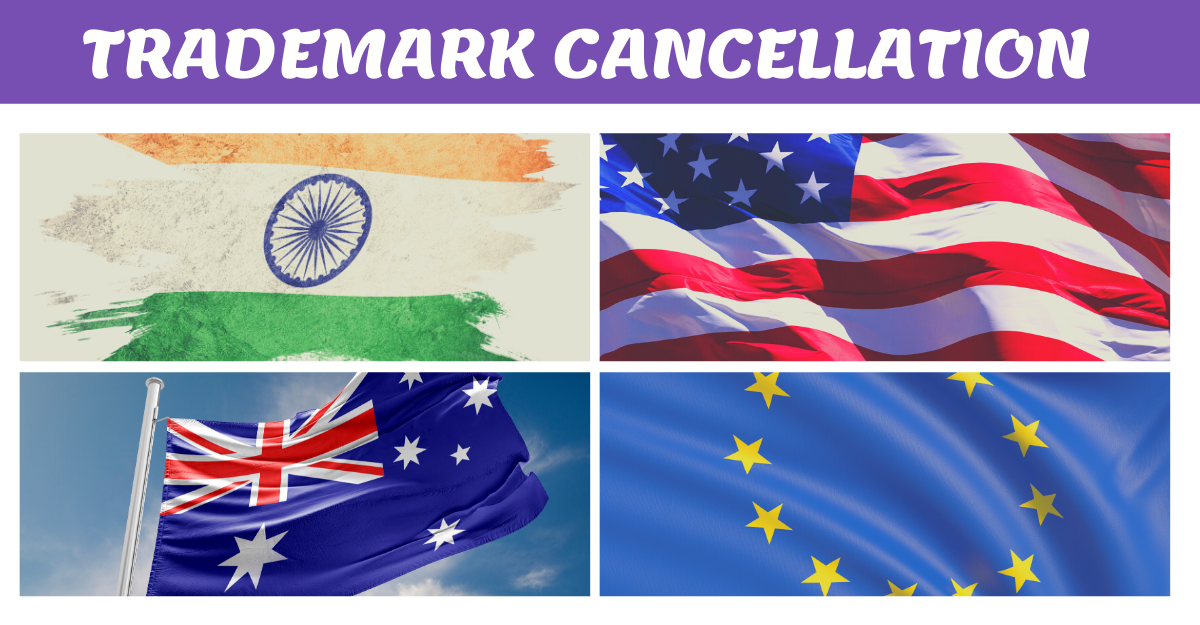A trademark cancellation can be initiated due to various factors. Provisions about cancellation ensure that the non-use trademarks or fraudulently registered trademarks do not remain registered. Let us look at the cancellation process in India, the United States, Australia, and Europe below. It provides further clarity concerning the grounds upon which revocation of exclusionary rights involves.
INDIA
The Trade Marks Act, 1999 provides for the removal of a trademark from the register. The trademark may either be associated with goods or services. The cancellation process starts when an aggrieved person makes an application to either the Registrar or the Appellate Board. The grounds upon which the aggrieved person may seek cancellation under Section 47 of the Act.
The first ground for cancellation is the absence of bona fide intentions. If there has been no bona fide intention from the applicant to use the particular trademark concerning the goods or services that it was registered for, then an application for cancellation can be moved. This cancellation is made to prevent defensive registration wherein trademark applications are filed for more classes than it is used for.
The second ground pertains to a period of five years and three months of non-usage. If a trademark has not been in bonafide use for the period, then a petition for removal can be allowed. However, the tribunal can reject the petition if it is convinced that there was a bonafide use of the trademark.
The ground of non-usage does not stand where Section 12 applies. Section 12 permits the applicant to register an identical or similar mark concerning the said class of goods and services. If the decision of the Registrar aggrieves either party, then an appeal lies to the High Court.
UNITED STATES OF AMERICA
Under the United States Trademark Law, the USPTO, as well as a federal court, has the authority to cancel a registration of a trademark. A trademark is canceled either for all the goods or services or some selected classes of goods and services. Broadly, there are four ways in which a trademark can be canceled.
First, when a third-party institutes cancellation proceedings. It can be challenged on various grounds before the Trademark Trial and Appeal Board (TTAB). If the third-party institutes the proceedings before a federal court, then according to the decision of the federal court, the USPTO will cancel the trademark registration.
Second, the failure to file a §71 affidavit or declaration can result in cancellation. The USPTO issues a notice if the right holder fails to meet the requirements under a §71 affidavit or declaration. A right holder must acknowledge and respond to the notice; otherwise, it would result in automatic cancellation. The other aspect is where the right holder does not timely file the required affidavit/ declaration which results in cancellation. It is a statutory requirement, which cannot be waived off.
Third, a voluntary surrender of registered extension protection will result in cancellation. This can be done in entirety or in part. If the right holder leaves out a particular class of goods or services in the §71 affidavits, then it is regarded as a part voluntary surrender of protection. The USPTO deletes the records of the trademark for goods/services that were left out.
AUSTRALIA
Cancellation proceedings can be invoked in Australia on various grounds. For example, if a particular registered mark has become generic, i.e., it has acquired the meaning of the good or service in general. It does not indicate that the good or service is from a specific trade source anymore, and thus, the right holder loses exclusionary rights.
Further, if the trademark consists of a sign that is related to a product that has been patented and that sign is the sole way in which the product can be described, then the trademark can be canceled. A trademark can also be canceled if the application was based on fraud or misrepresentation, or if the trademark would be likely to deceive the public.
EUROPE
The European Union Trademark Regulation provides two types of cancellation proceedings. The first one is where the rights of the proprietor are revoked, and the mark is invalidated from the date of the request. The second one is where the mark is removed from the register with a retrospective effect, and this is known as the declaration of invalidity.
Concerning revocation, if the mark is not been genuinely used for five years or has become generic, or has become misleading, then it becomes a ground for revocation.
Cancellation can be contested on two types of grounds. The first is based on absolute grounds of invalidity. If the mark was registered despite an absolute ground of refusal, such as the mark being descriptive, it could be declared invalid. Another aspect of this is when the application was filed in bad faith and for unlawful means. The invalidity based on relative grounds is based upon the principle of priority. This was when an earlier right existed, which would prohibit the use of the trademark.




